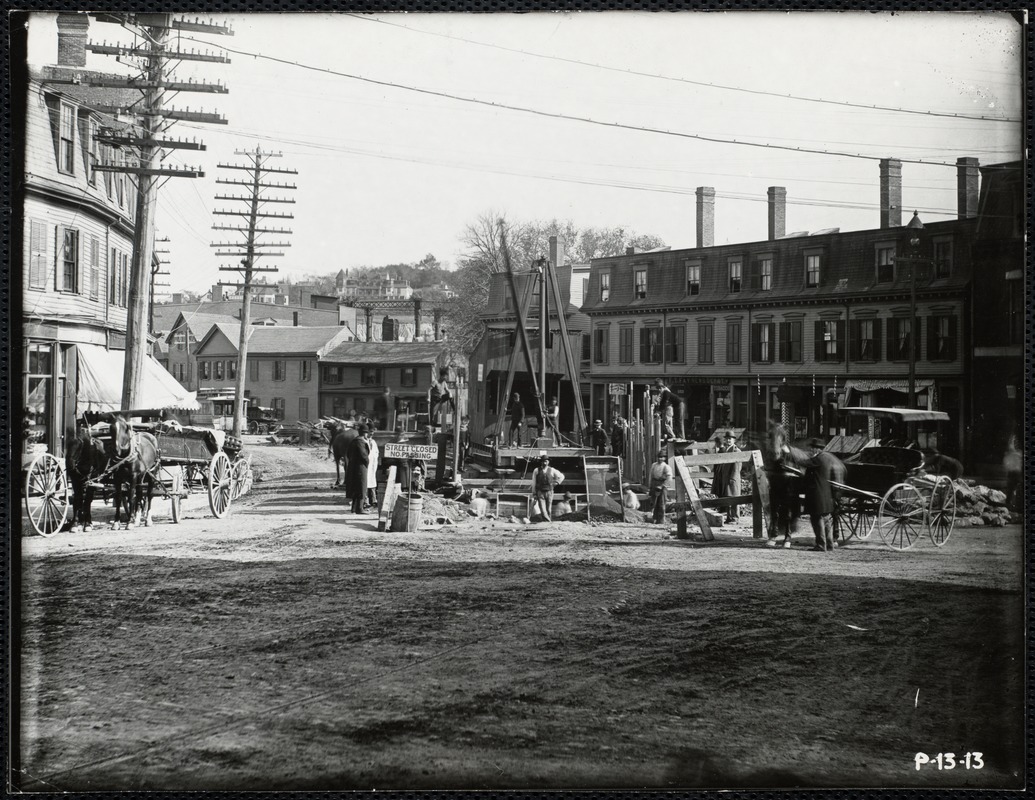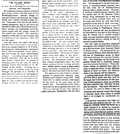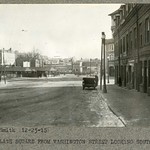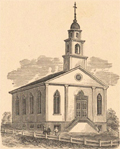|
The Society
Historical Information
Photo & Map Collections
Exploring Brookline
Links
Program Archives
|
Photo Collection
 |
Boylston St., circa 1876
Looking east towards the Village Square. Number 45 is on the far left.
[Source: Brookline Preservation Department]
|
 |
Oliver Whyte House, Walnut & High, circa 1860s
Located behind the Village Square fire station on the southeast corner of High St. and Walnut St. With the death of his widow the house was torn down in 1871. Note the two women on the stoop of the house.
|
 |
Relocation of the Village Brook, circa 1893
Looking east on lower Washington St. toward Huntington Ave, Boston. Walnut St. feeding in on the right. Note that this is one of two different views taken at the same time.
Tom Condon, Sr. Civil Engineer for Brookline writes:
The work shown is part of the relocation of the outlet of the Village Brook. …(in the pile of lumber in the background you can see a piece of the curved falsework used
to hold the brick arch until the cement mortar set.). Leverett Pond was created from the Muddy River marsh located just south of Washington Street by installing a stop plank manhole (in effect an adjustable height dam) in the new culvert under Washington Street. This stop plank manhole was necessary to hold back the pond since the Charles and therefore the Muddy Rivers were still tidal at that time. Presumably, Alexis French (who was both Olmsted's engineer and the Town Engineer) determined that more flow into this new pond was necessary. To provide this additional flow, the Village Brook which flows alongside what is now the MBTA "D" line was diverted into the culvert shown under construction. The culvert runs east down Washington Street, crosses Walnut Street, runs down Morss Avenue (now discontinued), across Pond Avenue and into Leverett Pond.
|
 |
Relocation of the Village Brook, circa 1893
Lower Washington St. going toward Boston angling to the left rear. Note that this is one of two different views taken at the same time. From right to left, looking at the south side of Washington St.:
- Sing Lee, laundry, #136
- John Barthelmes, hairdresser, #134
- Frank T. Fay, newsdealer, cigars and tobacco, #128
- William Frawley, custom shoemaker (note picture of boot on sign), #126
- Luigi Barba (aka Louis Barbour and Louis Barber), fruit, #126
On the left of the photo is the awning of Thomas S. Brown & Co., provisions, at #145 Washington St. Tom Condon, Sr. Civil Engineer for Brookline writes:
The work shown is part of the relocation of the outlet of the Village Brook. …(in the pile of lumber in the background you can see a piece of the curved falsework used
to hold the brick arch until the cement mortar set.). Leverett Pond was created from the Muddy River marsh located just south of Washington Street by installing a stop plank manhole (in effect an adjustable height dam) in the new culvert under Washington Street. This stop plank manhole was necessary to hold back the pond since the Charles and therefore the Muddy Rivers were still tidal at that time. Presumably, Alexis French (who was both Olmsted's engineer and the Town Engineer) determined that more flow into this new pond was necessary. To provide this additional flow, the Village Brook which flows alongside what is now the MBTA "D" line was diverted into the culvert shown under construction. The culvert runs east down Washington Street, crosses Walnut Street, runs down Morss Avenue (now discontinued), across Pond Avenue and into Leverett Pond.
[Source: Digital Commonwealth]
|
 |
Relocation of the Village Brook, February, 23, 1894
Tom Condon, Sr. Civil Engineer for Brookline writes:
The work shown is part of the relocation of the outlet of the Village Brook. …(in the pile of lumber in the background you can see a piece of the curved falsework used
to hold the brick arch until the cement mortar set.). Leverett Pond was created from the Muddy River marsh located just south of Washington Street by installing a stop plank manhole (in effect an adjustable height dam) in the new culvert under Washington Street. This stop plank manhole was necessary to hold back the pond since the Charles and therefore the Muddy Rivers were still tidal at that time. Presumably, Alexis French (who was both Olmsted's engineer and the Town Engineer) determined that more flow into this new pond was necessary. To provide this additional flow, the Village Brook which flows alongside what is now the MBTA "D" line was diverted into the culvert shown under construction. The culvert runs east down Washington Street, crosses Walnut Street, runs down Morss Avenue (now discontinued), across Pond Avenue and into Leverett Pond.
|
 |
Brookline Village, Village Square, 1885
The side road shown here will soon become part of the widening of Washington St. and its bridge over the tracks. Today's Rt. 9 is in the distance, Boston to the left.
[Source: Digital Commonwealth]
|
 |
Brookline Village, 1937
Looking east on lower Washington St. toward Boston. Parker Hill and N.E. Baptist Hospital upper right. Walnut St. on the right. Taken on 11/29/1937 by C. Parker, Brookline Engineering Dept.
|
 |
Brookline Village, 1937
Looking east on lower Washington St. toward Boston. Walnut St. on the right. Note scaffolding for the construction of the Brookline Theater on the left side of the street. All the buildings were raised in the 1960s as part of a large urban redevelopment program. Photo taken on 11/29/1937 by C. Parker, Brookline Engineering Dept.
|
 |
Brookline Village, December 23, 1915
Washington St. looking south. Start of Boylston St. background right. Guild building, foreground right. Only the fire station, partial view, remains.
[Source: Olmsted]
|
 |
Burns Pharmacy, 127 Washington St., Brookline Village
Thomas Edwards Burns (1875 - 1956 ) opened his pharmacy at 127 Washington St. in late 1905 after the closing of the Morlock bakery and restaurant in the 127-131 Washington St. - locations that were on the first floor of the Morlock Hotel. A 1917 postcard written by employee Ethan Ames Howard to his mother describes Burns as the “man on the right” in the photo. Burns Pharmacy remained at that location until the business was taken over in early 1942, becoming Hughes Drug. Co. by that October.
[Source: Joel Shield]
|
 |
Brookline Village: Chestnut Hill Trolley (Boylston St. - Ipswich St. - Brookline Ave.)
|
 |
Brookline Village, Guild Block Building, circa 1903
Boylston St. looking west to the left; Washington St. on the right. Pictured from left to right:
[#164 Washington St.] On the corner of the Guild Block building, the faded sign of the previous owner of the grocery store, Francis H. Bacon, is still visible to the right. Thomas F. McMahon, who had been a clerk in Bacon’s store, took over the business when Bacon died in 1898.
[#172 Washington St.] Henderson Dairy and T. A. Conroy, Gas and Electric Fixtures.
[#174 Washington St.] Horace James, Mason
[#176 Washington St.] George P. Johnson Fish Co.
[#178 Washington St.] W. H. Pazolt, Sign and Carriage Painting; and F. H. McMahan, Plumber
|
 |
Guild Block, Brookline Village
Lower Washington St. looking west. This is probably circa 1911 but an exact year is difficult to determine. The date spans of the visible businesses:
- #164 (aka 166) Washington St. (corner of the Guild Building), first floor: Thomas H. McMahon, Grocer. In 1898, he took over the existing business in which he had been a clerk and maintained it until 1919 when the building was sold to and replaced by the Brookline Bank.
- #166 Washington St.: The Brookline Print. Visible on the upper left of the building are the names of Wallace B. Conant and Carl A. Smith. Smith joined Conant’s business in 1909 and is no longer listed with the business after 1911.
- #166 Washington St.: Forster Bros., Upholsterers. Visible on the far upper left of the building is the sign for “Upholsterers”. The brothers were there from 1908 - 1917
- #21 Boylston St.: John H. Shea, Horse shoer, maintained his business there until 1913. In a 1909 photo there was a large sign hanging out front which is no longer visible.
[Source: Brookline Preservation Department]
|
 |
Village Square, December 12, 1934
[Source: Leo Sullivan]
|
 |
Brookline Village, circa 1875
This is the oldest known photograph of the Village which includes the “Guild Block”. On the corner is J. Anson Guild’s grocery store which was a Village fixture for many years. On the right side of the building are a number of small businesses: wheelwright, fish market, barber, plumber. The top floor was called “Goddard Hall” and was used for dances and meetings.
Only one side of Washington St. has a bridge over the railroad tracks. The small road to the right is essentially another lane of Washington St. with additional access under the bridge to White Place. In ten years, the bridge would extend across both lanes and the entrance to White Place would be raised to that level.
[Source: Brookline Public Library]
|
 |
Brookline Village, Washington St.
Looking north on Washington St. Only one side of Washington St. has a bridge over the railroad tracks. The small road to the right is essentially another lane of Washington St. with additional access under the bridge to White Place. In 1888, the bridge would be extended across both lanes.
|
 |
Brookline Village, circa 1913
Washington St. looking north. On the far left, the removal of the side of the Guild Building facing Boylston St. can be partially glimpsed. This was to accommodate the 1912 widening of Boylston St.
[Source: Digital Commonwealth]
|
 |
Brookline Village, circa 1910
Washington St., looking south at the Village Square
- [173 Washington St.] a partial view of the building
- [167/163 Washington St.] Edward J. Cameron, shoemaker (left) and Michael O'Keeffe, grocer (right)
- Trolley stand
- [Corner, Morss Ave. & Walnut St.] The large taxi billboard is sitting on top of the Brookline Riding School building at 2 Walnut St. Morss Ave is to the left. The building had been the barn housing the horse-drawn cars for the Metropolitan Railway Co.
- [6 Walnut St.] Macleod Bros. Furniture and Piano Moving
- [22 Walnut St.] immediately to the right of the “Renting an Automobile” sign is the store of Nils Lilja, Painting and Decorating
- [140 Washington St.] New fire station completed in 1908 and still in use today
- [#164 Washington St.] Thomas H. McMahon, grocer, on the corner of the Guild Block building, sign visible
- [#166 Washington St.] Forster Bros., Upholsterers, upstairs in the Guild Block building, sign visible
- [#166 Washington St.] T. A. Conroy, Gas and Electric Fixtures, upstairs in the Guild Block building, sign visible
[Source: Joel Shield]
|
 |
Brookline Village, Looking North on Washington St., 1865
This is one of the two earliest known photos of the Harvard Sq. area of Brookline Village. The business life of the Village was still largely centered along Lower Washington St. From left to right:
- Carriage in front of Kenrick Brothers, stoves and furnaces
- Carriage in front of Marshall Russell, Grocer [unconfirmed]
- Large tree in front of the house of Benjamin Davis
- "Panter’s Building" at the apex of Washington and Harvard streets. In 1859, John Panter acquired the former Baptist Church building, moved it forward into the apex of the two main thoroughfares, and created storefronts on the first floor.
- Behind the "Panter’s Building" is the steeple of the newer Baptist Church on Harvard St.
- Coming forward right from the church is the "Rooney Building" which was later raised up one story to accommodate stores underneath and is still standing.
- Foreground right is the train station. This was also the location of the telegraph office (sign visible) and the post office (washed out sign above)
|
 |
The Original Baptist Church
Erected in 1828 in Harvard Square. In 1858, the church moved to a new structure at the corner of Harvard St. and Pierce St. In 1859, John Panter acquired the former structure and moved it forward into the apex of the two main thoroughfares, Washington St. and Harvard St., and created storefronts on the first floor.
The church was the outgrowth of meetings first organized by Elijah Corey who sought an alternative to the First Parish Church which was located at the top of Walnut surrounded by the monied elite of Brookline to whom the parish appealed.
[Source: Digital Commonwealth]
|
|